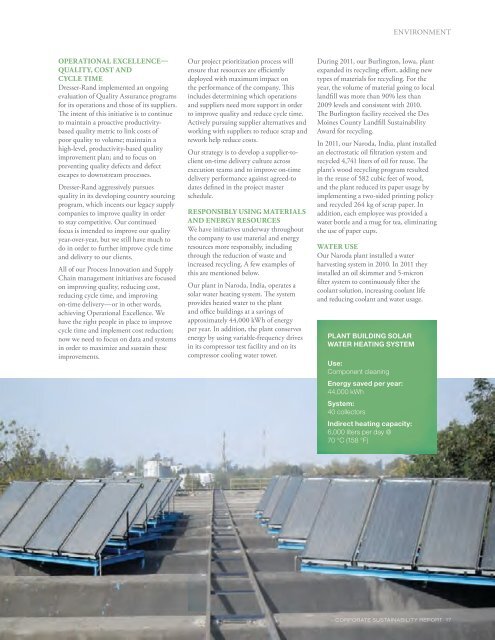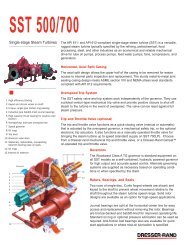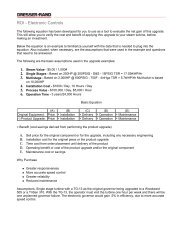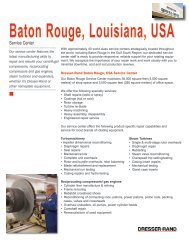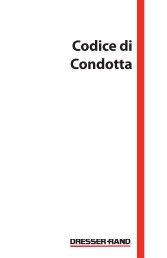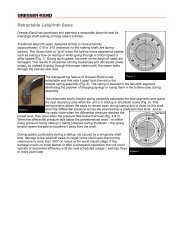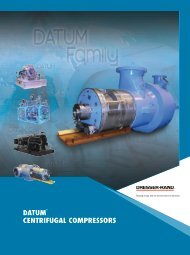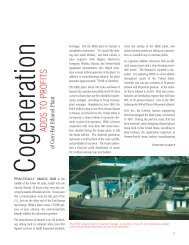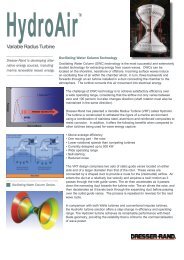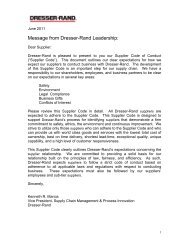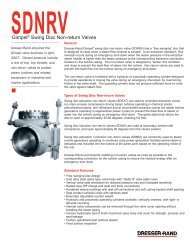case studies - Dresser-Rand
case studies - Dresser-Rand
case studies - Dresser-Rand
You also want an ePaper? Increase the reach of your titles
YUMPU automatically turns print PDFs into web optimized ePapers that Google loves.
OPERATIONAL EXCELLENCE—<br />
QUALITY, COST AND<br />
CYCLE TIME<br />
<strong>Dresser</strong>-<strong>Rand</strong> implemented an ongoing<br />
evaluation of Quality Assurance programs<br />
for its operations and those of its suppliers.<br />
The intent of this initiative is to continue<br />
to maintain a proactive productivitybased<br />
quality metric to link costs of<br />
poor quality to volume; maintain a<br />
high-level, productivity-based quality<br />
improvement plan; and to focus on<br />
preventing quality defects and defect<br />
escapes to downstream processes.<br />
<strong>Dresser</strong>-<strong>Rand</strong> aggressively pursues<br />
quality in its developing country sourcing<br />
program, which incents our legacy supply<br />
companies to improve quality in order<br />
to stay competitive. Our continued<br />
focus is intended to improve our quality<br />
year-over-year, but we still have much to<br />
do in order to further improve cycle time<br />
and delivery to our clients.<br />
All of our Process Innovation and Supply<br />
Chain management initiatives are focused<br />
on improving quality, reducing cost,<br />
reducing cycle time, and improving<br />
on-time delivery—or in other words,<br />
achieving Operational Excellence. We<br />
have the right people in place to improve<br />
cycle time and implement cost reduction;<br />
now we need to focus on data and systems<br />
in order to maximize and sustain these<br />
improvements.<br />
Our project prioritization process will<br />
ensure that resources are efficiently<br />
deployed with maximum impact on<br />
the performance of the company. This<br />
includes determining which operations<br />
and suppliers need more support in order<br />
to improve quality and reduce cycle time.<br />
Actively pursuing supplier alternatives and<br />
working with suppliers to reduce scrap and<br />
rework help reduce costs.<br />
Our strategy is to develop a supplier-toclient<br />
on-time delivery culture across<br />
execution teams and to improve on-time<br />
delivery performance against agreed-to<br />
dates defined in the project master<br />
schedule.<br />
RESPONSIBLY USING MATERIALS<br />
AND ENERGY RESOURCES<br />
We have initiatives underway throughout<br />
the company to use material and energy<br />
resources more responsibly, including<br />
through the reduction of waste and<br />
increased recycling. A few examples of<br />
this are mentioned below.<br />
Our plant in Naroda, India, operates a<br />
solar water heating system. The system<br />
provides heated water to the plant<br />
and office buildings at a savings of<br />
approximately 44,000 kWh of energy<br />
per year. In addition, the plant conserves<br />
energy by using variable-frequency drives<br />
in its compressor test facility and on its<br />
compressor cooling water tower.<br />
ENVIRONMENT<br />
During 2011, our Burlington, Iowa, plant<br />
expanded its recycling effort, adding new<br />
types of materials for recycling. For the<br />
year, the volume of material going to local<br />
landfill was more than 90% less than<br />
2009 levels and consistent with 2010.<br />
The Burlington facility received the Des<br />
Moines County Landfill Sustainability<br />
Award for recycling.<br />
In 2011, our Naroda, India, plant installed<br />
an electrostatic oil filtration system and<br />
recycled 4,741 liters of oil for reuse. The<br />
plant’s wood recycling program resulted<br />
in the reuse of 582 cubic feet of wood,<br />
and the plant reduced its paper usage by<br />
implementing a two-sided printing policy<br />
and recycled 264 kg of scrap paper. In<br />
addition, each employee was provided a<br />
water bottle and a mug for tea, eliminating<br />
the use of paper cups.<br />
WATER USE<br />
Our Naroda plant installed a water<br />
harvesting system in 2010. In 2011 they<br />
installed an oil skimmer and 5-micron<br />
filter system to continuously filter the<br />
coolant solution, increasing coolant life<br />
and reducing coolant and water usage.<br />
PLANT BUILDING SOLAR<br />
WATER HEATING SYSTEM<br />
Use:<br />
Component cleaning<br />
Energy saved per year:<br />
44,000 kWh<br />
System:<br />
40 collectors<br />
Indirect heating capacity:<br />
6,000 liters per day @<br />
70 °C (158 °F)<br />
CORPORATE SUSTAINABILITY REPORT 17


